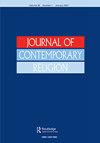过度无聊的精神意义
IF 0.6
3区 哲学
0 RELIGION
引用次数: 0
摘要
本文章由计算机程序翻译,如有差异,请以英文原文为准。
The Spiritual Significance of Overload Boredom
reading of terms like ‘religion’, ‘religions’, ‘mysticism’, and mysterium tremendum is much more nuanced and complex and makes much more of the plurality within both religious ideas and feelings than he has generally been credited with. Yet, it is Otto’s vision of a common core of all religions that enables Melissa RaphaelLevine (chapter 6) to give a fascinating account of the numinous consciousness and modern Jewish thought and Tulasi Srinivas (chapter 7) to suggest ‘wonder’ as creating a new understanding of certain experiences “that transform our knowledge of what is by awakening us to realities of what can be” (181). It is this same vision of a common core that enables Robert Baum to explore the numinous in traditional African religions (chapter 9). As Baum recognizes, Otto was an heir of nineteenthcentury evolutionary accounts of religion and had relegated traditional religions to the category of pre-religious. However, Baum demonstrates that there are present in African religions not only those aspects that evoke fear and trembling (that Otto discerned) but also deities of care and compassion who can ease obstacles from people’s paths through life. What then is the relevance of Rudolf Otto to the contemporary study of religion? Alles reminds us that, for Otto, the category of religion is used strategically to address three principal concerns: firstly, that religion not be lost by deriving it from something else; secondly, that the diversity of empirical religions be preserved; thirdly, that religion as practised be rescued from dead theology. These are principles in the study of religion as valid now as they were a century ago and an enduring legacy of Otto’s work. They ensure now, as they did then, that the student of religion has a scholarly sensibility attuned still to the presence of the numinous in modern religious life.
求助全文
通过发布文献求助,成功后即可免费获取论文全文。
去求助
来源期刊

Journal of Contemporary Religion
RELIGION-
CiteScore
1.20
自引率
0.00%
发文量
59
期刊介绍:
Journal of Contemporary Religion is an international peer reviewed journal. Its purpose is to both document and evaluate the anthropological, sociological, psychological, and philosophical aspects of emerging manifestations of religiosity in any part of the world—whether within innovative movements or mainstream institutions. The term ''religion'' in the title of this journal is understood to include contributions on spirituality. Moreover, as the journal title suggests, the focus is on contemporary issues. Therefore, the editors of Journal of Contemporary Religion welcome submissions which deal with: classical topics in the study of religion, such as secularisation and the vitality of religion or traditional sectarian movements; more recent developments in the study of religion, including religion and social problems, religion and the environment, religion and education, the transmission of religion, the materialisation and visualisation of religion in various forms, new forms of religious pluralism, the rise of new forms of religion and spirituality, religion and the Internet, religion and science, religion and globalisation, religion and the economy, etc. theoretical approaches to the study of religion; discussions of methods in relation to empirical research; qualitative and quantitative research and related issues. The Journal includes reviews of books which reflect the above themes.
 求助内容:
求助内容: 应助结果提醒方式:
应助结果提醒方式:


